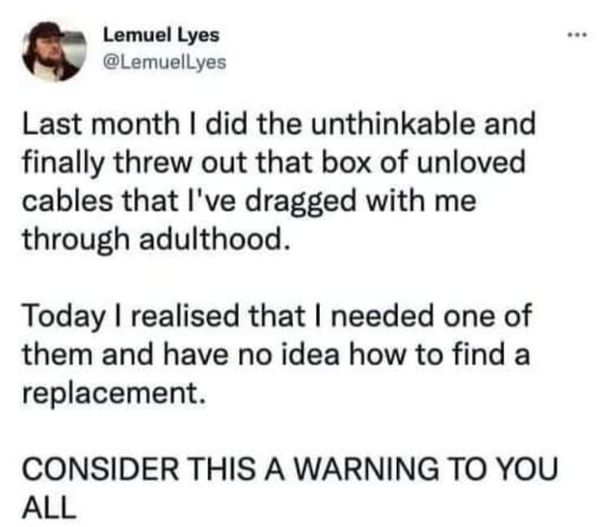this post was submitted on 20 Aug 2024
2226 points (99.3% liked)
Microblog Memes
8002 readers
4062 users here now
A place to share screenshots of Microblog posts, whether from Mastodon, tumblr, ~~Twitter~~ X, KBin, Threads or elsewhere.
Created as an evolution of White People Twitter and other tweet-capture subreddits.
Rules:
- Please put at least one word relevant to the post in the post title.
- Be nice.
- No advertising, brand promotion or guerilla marketing.
- Posters are encouraged to link to the toot or tweet etc in the description of posts.
Related communities:
founded 2 years ago
MODERATORS
you are viewing a single comment's thread
view the rest of the comments
view the rest of the comments

Okay so the magic sauce here is USBC-PD which is some type DC-DC voltage converter. Then it's just a matter of barrel connector roulette to find the appropriate plug for each device.
I live part time out of an RV semi-off grid for some of the year and the "using AC/DC power packs off an inverter" always struck me as super dumb which your data basically confirms.
What you've given me is a roadmap to figure this out without having to reinvent the wheel.
You got it man, right on. I would like to give you some more information about the usbc-pd stuff and some of the things I figured out with it. So here is a link to the farsense usbc-pd to standard DC 5.5x2.5 adapter with manually selectable voltage based on button press. This cable is the most important part and I will explain why its so important. USBC-PD essentially requires three things to work right.
The first thing is a charger(the DC to DC inverter in our context) ideally rated at either 65w or 100w as both of those support up to 20v the difference being 65W can only go up to like 3.25 amps or something like that. The simplest and cheapest dc to dc chargers are usbc-pd car plug chargers which convert the 12v from a car battery to the required voltages. The anker one I just linked is a little pricy you can find them for cheaper but it seems good quality and I like the cable I bought from them.
Speaking of, the second thing you need is a USBC-PD power cable that specifically supports the same wattage your charger outputs. Not all of them are rated the same you gotta use a specifically rated cable that handles higher voltages. If you use a 100W charger gotta get a 100W cable. I've had good luck with this anker one
The third and most crucial thing to understand for our purposes, is that you need a communication chip on the appliance side that tells the charger/inverter what voltage to send. The nice thing about that farsense manual voltage selector cable is that it has that communication chip built in with all the different voltages to pick from. Thats the real secret sauce of this setup. That cable and its ability to choose voltage levels is the heart of it. All thats left is to track down the specific dc 5.5x2.5 to X adapter bit and select the proper voltage on the cable and its good to go.
There are USBC-PD adapter bits that have this chip built in for a specific voltage, commonly for laptops at 19-20v. If you manage to track down the proper usbc-pd to barrel plug adapter at your specific needed voltage it will cut out having to manually set the voltage each time you plug it in compared to the farsense cable. But it may be hard tracking down such a specific adapter bit.